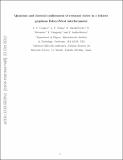Quantum and classical confinement of resonant states in a trilayer graphene Fabry-Pérot interferometer
Author(s)
Campos, Leonardo; Young, Andrea Franchini; Surakitbovorn, Kawin; Watanabe, K.; Taniguchi, T.; Jarillo-Herrero, Pablo; ... Show more Show less
DownloadJarillo-Herrero_Quantum and.pdf (3.892Mb)
PUBLISHER_POLICY
Publisher Policy
Article is made available in accordance with the publisher's policy and may be subject to US copyright law. Please refer to the publisher's site for terms of use.
Terms of use
Metadata
Show full item recordAbstract
The advent of few-layer graphene has given rise to a new family of two-dimensional systems with emergent electronic properties governed by relativistic quantum mechanics. The multiple carbon sublattices endow the electronic wavefunctions with pseudospin, a lattice analogue of the relativistic electron spin, whereas the multilayer structure leads to electric-field-effect tunable electronic bands. Here we use these properties to realize giant conductance oscillations in ballistic trilayer graphene Fabry-Pérot interferometers, which result from phase coherent transport through resonant bound states beneath an electrostatic barrier. We confine these states by selectively decoupling them from the leads, resulting in transport via non-resonant states and suppression of the giant oscillations. The confinement is achieved both classically, by manipulating quasiparticle momenta with a magnetic field, and quantum mechanically, by locally varying the pseudospin character of the carrier wavefunctions. Our results illustrate the unique potential of trilayer graphene as a versatile platform for electron optics and pseudospintronics.
Date issued
2012-12Department
Massachusetts Institute of Technology. Department of PhysicsJournal
Nature Communications
Publisher
Nature Publishing Group
Citation
Campos, L.C., A.F. Young, K. Surakitbovorn, K. Watanabe, T. Taniguchi, and P. Jarillo-Herrero. Quantum and Classical Confinement of Resonant States in a Trilayer Graphene Fabry-Pérot Interferometer. Nature Communications 3 (December 4, 2012): 1239.
Version: Author's final manuscript
ISSN
2041-1723